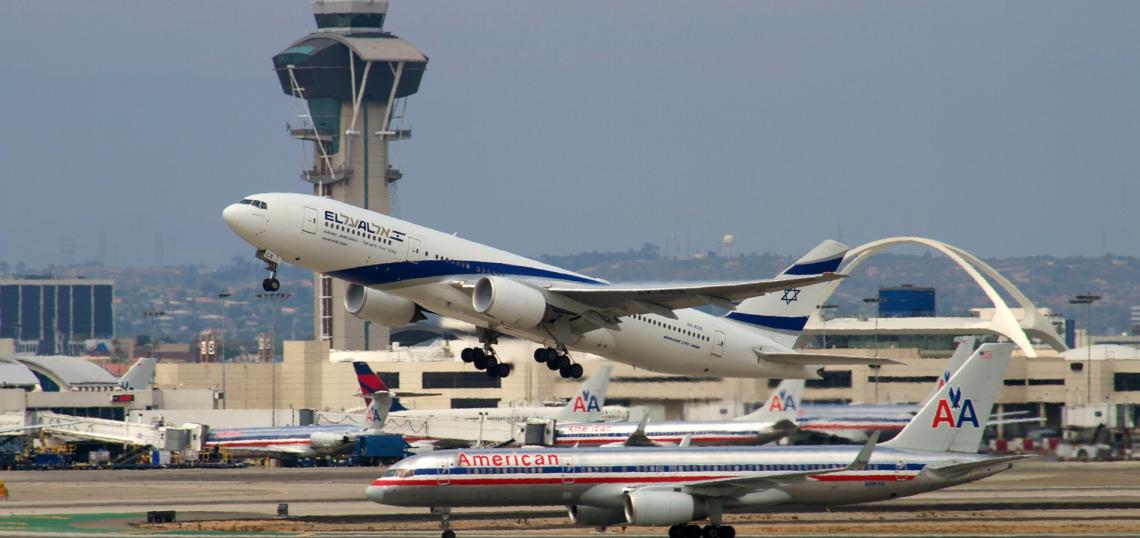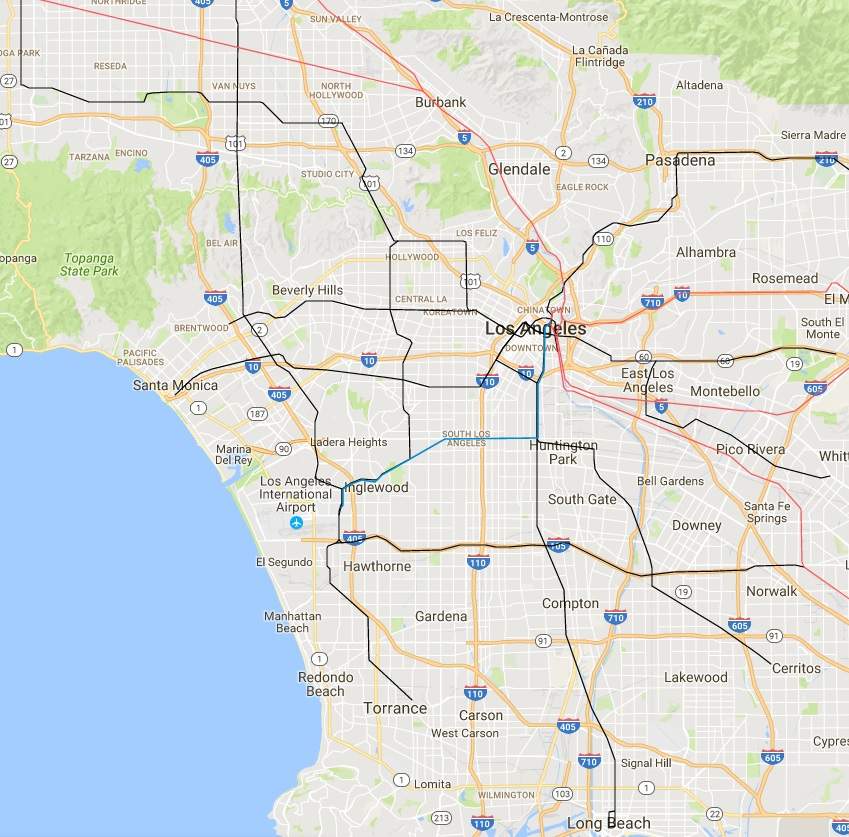Over the past several weeks, Phil Washington has indicated on multiple occasions that Metro is reviving the idea of a Union Station-to-LAX express train. This concept has been studied before, as recently as 2009 when Metro looked at using its Harbor Subdivision right-of-way for such a service. The MTA’s Office of Extraordinary Innovation will be heading the new analysis, and specifics - beyond the proposed termini - are currently unknown. However, we can examine the general utility of applying the airport express concept to diffuse Los Angeles using the previous study and our knowledge of Measure M’s expenditure plan.
Phil Washington’s comments come amidst a surge of renewed interest among politicians in airport-oriented transit for the nation’s largest cities. Chicago and New York are both considering new airport express trains of their own, proposals which have engendered skeptical responses from writers covering those cities. Whet Moser, for Chicago Mag, questions the need of the premium service, which will run less frequently, cost more, and save riders potentially 20 minutes compared to the existing Blue Line rail link. He suggests that the project may amount to nothing more than a “signal” by Rahm Emmanuel of Chicago’s peer status to other world cities. Alon Levy at Pedestrian Observations is similarly dismissive of Governor Cuomo’s new plan to connect New York’s JFK airport to Manhattan via a one-seat ride, concluding that “the idea of the express air-rail link is a fetish rather than a transportation project.” Cuomo is also moving forward with a plan for a new AirTrain link to LaGuardia Airport, which Yonah Freemark panned, saying the proposed route would benefit “almost no one.”
It is hard to look on Los Angeles’ airport express as somehow more viable than these other projects. Even before OEI lets us in on the details, the premise itself seems suspect in Los Angeles. Jarrett Walker says the position of the airport in the overall transit network matters more than a direct connection to downtown, which seems all the more true given downtown Los Angeles’ diminished role as a center for business and tourism compared with its eastern counterparts. Levy says that the express connector needs to offer arriving visitors a one-seat ride to their hotels, and departing locals a centralized connection that they can access from their own neighborhood. At face value, linking Southern California’s major airport to its primary rail hub seems like it could accomplish these goals, but digging a little deeper casts doubt on that assumption.
First, regarding incoming tourists trying to get to their hotels, we immediately find that downtown makes up a small share of the local market. The neighborhood’s present inventory of about 6,500 rooms is good for 6.5% of the county’s total stock. When factoring in Disneyland and the Anaheim Convention Center as likely destinations for arriving LAX passengers, the percentage drops further.
There are 5,500 new hotel rooms planned or under construction downtown, but, even if all of these are completed, the central business district would still lag behind the Hollywood/Beverly Hills area, which will have about 14,000 rooms when current projects are completed, including a large proportion of the high-end market. This doesn’t mean that the express should go to Beverly Hills instead of Union Station, it simply means that demand is widely distributed in Los Angeles, much as we would expect it to be. It is hard to select – and subsequently to justify – any two specific points for express service.
Even if downtown were a sufficiently strong node relative to other potential locations, the proposed project also fails Levy’s precept of offering tourists a one-seat ride. Within downtown, the hotels are clustered on the Figueroa corridor and not by Union Station, a pattern which will be reinforced by the new construction, most of which surrounds Los Angeles’ convention center in South Park. We might then expect that an express to 7th/Metro or Pico would be more useful, although it would surely be more expensive to construct.
As regards outgoing Angelenos, the key is that end of the express line should be a prime connectivity point through which the majority of passengers must pass, or, at least through which they can reroute their trips with minimal disruption. It’s true that Union Station is Metro’s hub, and it’s the terminal for Metrolink commuter trains as well, but it actually doesn’t fit this requirement well either. That may surprise you if you think of Metro like this, because the current Metro system has been built off of a radial system centered in downtown. However, this design is out of step with the layout of the city, and forces passengers to connect through downtown that would take a more direct route to their destination if it were available.
As it happens, with the passage of Measure M, Los Angeles has guaranteed that it will gradually transform its rail network into a hybrid grid system over the course of this century. There will be a growing number of ways to bypass Union Station and 7th/Metro, and, for most of the City of Los Angeles, traveling to LAX won’t require a trip downtown at all.
Below is a picture of what the complete buildout of Measure M rail projects might look like. Metro rail lines are shown in black, Metrolink lines in red, and a theoretical LAX express is indicated in blue.
Unlike in Denver, where Phil Washington previously stewarded construction of the A Line commuter train from downtown to DIA, Los Angeles’ airport is embedded in the one of the city’s busiest areas. This is important as it makes it easier to, as Walker emphasizes, connect the airport to many places on the transit grid via on-the-way routes.
While Angelenos and visitors have bemoaned the lack of a convenient rail connection to the airport for decades, Measure M funds at least 3 such connections. The Crenshaw, Sepulveda, and Green lines will all offer direct service to the LAX people mover. This effectively increases the pressure on an express from Union Station to provide fast trips to the airport. Almost no passengers will originate in the vicinity of Union Station, which means that they will have to get there first. Since downtown requires out-of-direction travel for most airport-bound travelers, the time it takes them to get to Union Station eats away at the time-savings offered by an express service.
The previous study estimated that an express train using the Harbor Subdivision could reach the airport from Union Station in 20 minutes, assuming full grade separation and no intermediary stops. Given those constraints, let’s look at a table of some key connection points in the Metro network and see if passengers might be expected to opt for a Union Station express.
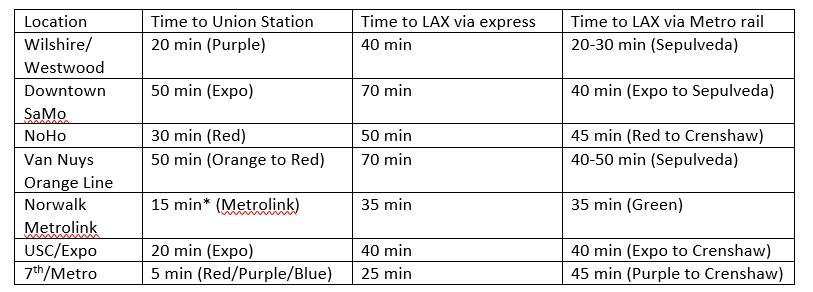
If a passenger is close to the any of the local rail lines that will provide service to the airport, then they are almost always better off going for that option. It takes so long to get to Union Station from most places that even an ideal express service isn’t fast enough. Unfortunately, almost everywhere west and south of downtown, including Orange County, falls into that category. Even in downtown, we see that USC is served better by planned local service (accounting for probable disparities in frequency and cost) than it would be by an express service to downtown. That’s a bad sign, considering USC’s large population of international students would theoretically make an ideal market for a downtown express train.
Turning to the service itself, Metro assumed a travel time of 20 minutes, which is faster than the estimated 35 minutes it takes for existing FlyAway service to make the same trip. But this travel time is possible only on the assumption of a fully grade-separated, non-stop service. Because of these conditions, Metro also found that the airport express was the most expensive option and that it served the fewest riders of all candidate uses for the corridor. In 2009, the project was projected to cost $1-$2 billion. Things have changed since then, but not in any way that would make the project cheaper. Sections of the Harbor Subdivision track were removed for the Crenshaw Line, the LAX People Mover was designed away from Century Boulevard, and an active transportation corridor has entered the design phase on Slauson.
By Metro’s model, which staff said did not take into account special purpose trips like those to catch a flight at the airport, the express would have a projected 641 boardings per day. Metro speculated that the true projected ridership “would likely be substantially more than the current FlyAway ridership from LAUS to LAX of approximately 1,200 riders per day.” It is probably true that the express would attract more riders than the FlyAway service, if the costs were equal. However, the express will also find itself in a zero-sum competition for employees with the existing Metro rail network. Employees don’t need the features that premium fare-paying passengers will expect, and, if the trip isn’t shorter overall, there’s no reason for them to take the express instead of using the cheaper, more expansive local rail network.
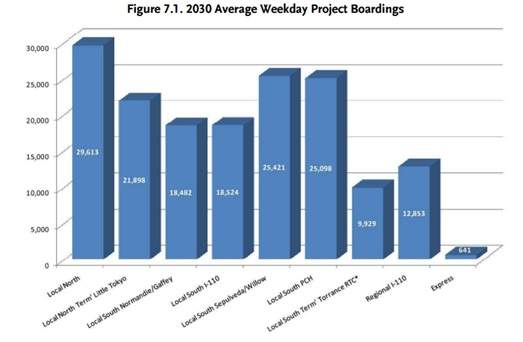
There is also reason to doubt Metro’s ability to run nonstop service between downtown and the airport. Doing so, as Henry Fung has noted previously, would likely run afoul of federal civil rights statutes in disproportionately conferring the benefits of the project on a wealthier, whiter customer base while saddling a poor minority community with the disruptive byproducts of those benefits. As a result, a few stops would probably be added in South Central. But, after all, Washington said he told his people in Denver, “I want the train to get from downtown to the airport in 30 minutes. I don’t care how you do it.” So, we probably would expect only the minimum number of stations to be added, because adding more would needlessly slow down the overall speed of the express train. But there are far more people in South Los Angeles in need of a better connection to the Metro rail network than there are potential express patrons. The use of the Harbor Subdivision for express service should, as a result, be a secondary concern to better serving the needs of existing residents. The continued pursuit of an airport express seems here, as in Chicago, to indicate a desired status boost more than clear transit need.
If the billions for construction of this line can somehow be secured, it would be better spent improving parts of the rail network that would reduce trip times between the airport and downtown while also improving the commutes of regular riders.
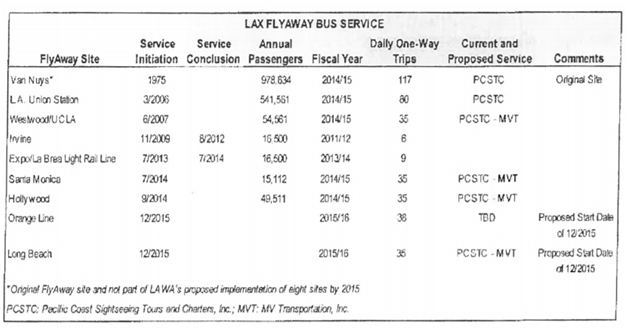
These could include grade separations for the Expo Line between downtown and Crenshaw or building the desired Crenshaw Subway through Park Mesa Heights Considering that 60% of FlyAway ridership originates in Van Nuys and Westwood, it might even be more beneficial to ensure that the entire Sepulveda Line is built below-grade. Any of these expenditures would spread their benefits more generously while also improving trips for airport bound commuters.
Scott Frazier is a graduate student at Cal State University Los Angeles in Public Administration. Follow him on Twitter @safrazie.




